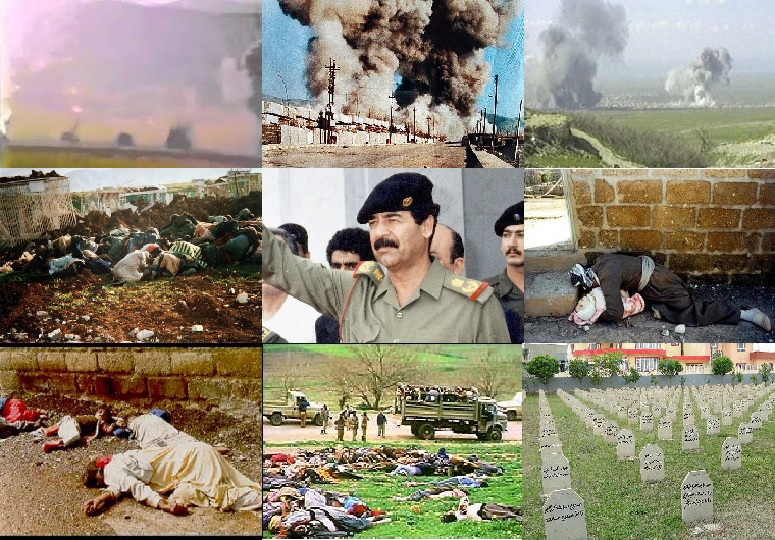The Mojahedin-e Khalq Organization (MeK) significantly contributed to the distressing suppression of Iraqi Kurds amidst the Persian Gulf War.
The anti-Iran terrorist Mojahedin-e Khalq Organization (also known as MKO or MeK) significantly contributed to the distressing suppression of Iraqi Kurds amidst the Persian Gulf War. This dark chapter, marked by violence and bloodshed, is a poignant reminder of the atrocities committed against the Iraqi Kurds.
On the occasion of the International Day of Commemoration and Dignity of the Victims of the Crime of Genocide, we reflect on the profound impact of MeK’s involvement in the brutal crackdown on the Kurdish community. As part of our commitment to shedding light on historical truths, we will provide a translation from the book “Mojahedin-Khalq Organization: Arising & the End” vol.3 published by the Political Studies and Research Institute (PSRI) offering insights into the events surrounding this tragic episode in history.
“The MEK are the protectors of the Iraqi borders and are like the Iraqi army. Listen to them and follow their instructions.” Saddam Hussein (1)
During the Persian Gulf War, the Iraqi Kurds took advantage of the weakness of the central government and seized control of the Kurdish regions. To keep Saddam’s regime in power and under the pretext that the Islamic Republic of Iran was attacking MEK bases in Kurdish territories, Rajavi moved his forces to these areas to suppress Iraqi Kurds until Saddam’s troops arrived from the south (2).
At the beginning of Iraq’s occupation of Kuwait, the MEK were settled in an area called Nawjul (located in northern Iraq) (3) where Iraqi Kurds used to live. However, it had been completely evacuated before being handed over to them! This means that Saddam’s army attacked the towns and villages of this region and killed its people or made them flee to Iran and Turkey. A few months after the Operation Eternal Light (Mersad), Saddam entrusted the protection and guarding of Nawjul to Rajavi’s elements where they planted wheat and barley to fill their days. When the Persian Gulf War began, Rajavi’s forces moved from their camp known as Ashraf to Nawjul.
During air attacks of US and its allies on the military and strategic regions of Iraq, MEK camps and shelters remained immune from damage according to some kind of agreement. For example, two large Iranian flags along with pictures of Masoud and Maryam were installed in Ashraf and Nujal bases, which were easily visible to the attack aircrafts (4).
Having faced defeat, Saddam brought all remaining forces to the border with Kuwait. As a result, northern areas were evacuated of Ba’athist forces. In this situation, an opportune moment was created for Iraqi Kurdish groups to launch raids into these areas and once again reside there.
In the northern areas, the Kurds occupied the major cities of Mosul and Sulaymaniyah and then advanced towards cities such as Tuz, Kifri, and Jalawla. With the occupation of these cities, it was enough for the Kurds to pass through Suleiman Beg’s route to reach the main road and advance directly towards the cities of Khales and Baghdad. At that point, no force could have stopped them (5).
The clash between Rajavi’s forces and the Kurds occurred at this point. We present two accounts of this incident. The first narrative consists of excerpts from a report submitted by the US Department of State to the Congress:
In March 1991, following Operation Desert Storm, the NLA reportedly fought against the Iranian Revolutionary Guards (The Islamic Revolution Guards Corps or IRGC) near the border town of Qasr-e Shirin. Analysts assume that Saddam permitted the NLA to cross into Iran at this time in order to signal that he would not tolerate Iranian support for a Shi’a uprising in southern Iraq (6). At that time, the Iraqi Kurds also claimed the Mojahedin had assisted the Iraqi army in its suppression of the Kurds, “a claim-substantiated by refugees who fled near the Iranian border.” (7) The leader of the patriotic Union of Kurdistan of Iraq, Jalal Talabani, told reporters that “5,000 Iranian Mojahedin joined Saddam’s forces in the battle for Kirkuk.” (8)
A recent Wall Street Journal report stated that the NLA’s “only major offensive in the past six years came in 1991, just after the (Persian) Gulf War, when Saddam Hussein ordered Mr. Rajavi to help quell a Kurdish revolt in northern Iraq, participants in that operation say.” (9)
A former MKO member who was in Iraq said his trouble with the Mojahedin leadership, began when he questioned the MKO’s operation against the Kurds.” (10)
References
1. Shams Haeri, The Marsh, p. 27. The author has mentioned that he, along with other prisoners, heard this message from the Iraqi radio in the college prison (one of the MEK prisons in Iraq) in Ashraf barracks.
2. The US State Department report with reference to a Jalal Talabani’s interview and the Wall Street Journal report on October 4, 1994; also a research report of the German Green Party
3. This region is located between the city of Kirkuk and the Kurdish-inhabited cities of Kifri and Tuz.
4. Asadi, The Reactionary, pp. 86-93
5. ibid
6. Michael Theodoulou, The Times, April 2,1992; Alan Cowell, New York Times, June 5,1991
7. Associated Press report, May 10, 1991
8. Michael Theodoulou, The Times, April 2,1992
9. Peter Waldman, The Wall Street Journal, October 4, 1994
10. ibid


